26 November, 2003
A windy day here at camp, with a weather report calling for even
stronger winds and some snow later in the day. Definitely not a
great forecast if you want to photograph and weigh seals, so it was
time to come up with some alternative plans. Since I'd been hoping
to visit one of the other research camps out on the ice, this seemed
like a perfect opportunity. After calling ahead to find out what
time might be best for our visit, we saddled up our snowmobiles and
headed off for the Penguin Ranch.
Now, the Penguin Ranch is not your ordinary ranch. There are no
cowboys and the only livestock they work with is a small group of
Emperor Penguins. The head of ranch operations is Dr. Paul Ponganis,
a research physiologist based out of the Scripps Institute of
Oceanography, who is examining the diving physiology of the Emperor
Penguin. These birds regularly dive to depths of up to 500 meters,
spending 8 to 10 minutes at a time underwater. His group is
measuring the effects of those dives on the oxygen content of the
birds' blood. Another member of the ranch crew, Katsu Sato of
Tokyo's National Institute of Polar Research, is testing new data
recorders that can be attached to the penguins.
Emperor Penguins are difficult to study in the wild. The Penguin
Ranch has developed techniques for studying them 'almost' in the
wild-they have 13 to 14 penguins at any one time living in a corral
at the ranch. This corral has a low fence, and is equipped with 2
dive holes through the ice. Since these are the only holes for many
kilometers, the penguins will dive and return through the same hole,
remaining within the corral between dives. The penguins can be
caught, anesthetized, and equipped with sensors that monitor oxygen
saturation levels in their blood stream and in the air sacs of their
lungs while they are diving under the ice and retrieved from the
penguins after their days dives are completed. In addition, some of
the penguins have been equipped with Katsus's data recorders. These
recorders have a small accelerometer that measures how fast they are
going underwater, as well as sensors that can measure the speed, body
angle, and the depth of the dive. The entire sensor package is less
than 15 cm long and is light enough to be attached to the penguin's
back.
Data collected during the dives has shown that the blood oxygen
concentration in the birds can go from 20% down to 2% at the end of a
diving sequence. This group is working to find out what the aerobic
threshold might be for the penguins and how this might limit the
length or depth of their dives. Katsu's work this season is focusing
on perfecting the sensors. A few years ago he worked with the Weddell
Seal project at Big Razorback, using sensors to determine diving
depths and foraging behavior for some of those seals. Katsu worked
with TEA Kolene Krysl while at Big Razorback-so you can learn more
about his work there by accessing her journals from the archives.
The sensors he is using on the penguins are miniature versions of
those used on the seals. He pointed out one big difference between
the way a seal dives and how a penguin dives-seals glide downward
through the water column and use their flippers to propel themselves
back up, while the penguins stroke on the downward trip and glide to
the surface.
The logistics of creating a penguin corral are interesting. Once a
hole is drilled through ice, it presents an open invitation for
Weddell Seals. To prevent seals from coming up through the ice in
the center of the corral, the researchers have drilled two additional
holes through the ice in unique locations-under their lab and kitchen
huts. Each of these huts has removable hatches in their floors that
can be opened to expose the holes below. While we were talking with
Dr. Ponganis in his lab, Wally the Seal surfaced every few minutes to
exhale loudly and take a gulp of fresh air. Not everyone can say
that they have a seal in their lab! At night the penguin's holes are
'corked' with a large, insulated circle of plywood to prevent them
from escaping and to keep out unwanted seal visitors.
The best part of our visit to the Ranch was the chance to climb down
into the famous 'Ob Tube'. This 20-footlong and 3-foot wide tube is
set down through a hole in the ice near the penguin's corral. It's a
pretty tight squeeze in your bunny boots and thick parka-definitely
not a place for claustrophobics! One person at a time can climb down
the narrow tube and sit on a bench in a small viewing chamber under
the ice. This is as close as I'll ever get to diving under the ice.
What an incredible treat to sit there under the ice watching Emperor
Penguins drop through their hole and fly through the clear water in
front of you. The ice above was translucent, with a beam of light
shining down like a beacon through the hole. It was easy to see how
seals under the ice use that light to find their holes to return to
the surface.
Although we all felt like we could sit all day under the ice watching
the penguins, we knew it was time to let Dr. Ponganis and his crew
return to their work. It was time to leave the ranch and return to
Big Razorback, so we saddled up the snowmobiles and rode off into the
(non)sunset.
Daily Haiku:
Climb into the tube
View a world under the ice
Look at that penguin!
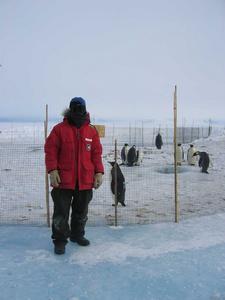
Dr. Paul Ponganis stands in front of the penguin corral.
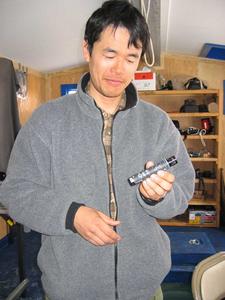
Katsu Sato shows the sensor that he places on the penguins. The device has a small propeller in one end to measure acceleration as the penguin dives, as well as other sensors that record dive angle and speed.
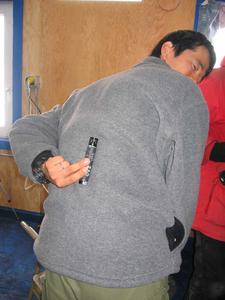
Katsu demonstrates proper placement of the sensor.
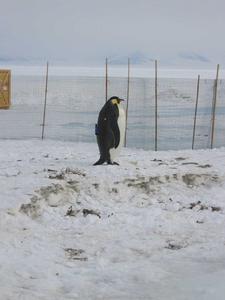
Here's an Emperor Penguin ready to go swimming and record some data.
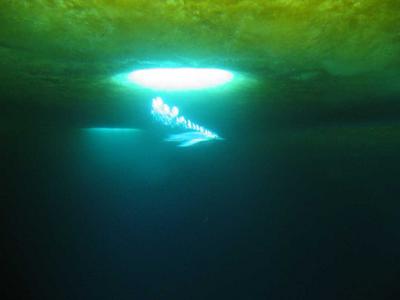
This is a view from within the Ob Tube. It was amazing to be able to watch the penguins diving and swimming.

Not every hut has its own seal!
Contact the TEA in the field at
.
If you cannot connect through your browser, copy the
TEA's e-mail address in the "To:" line of
your favorite e-mail package.
|
